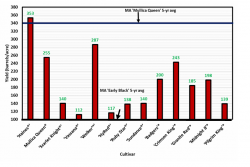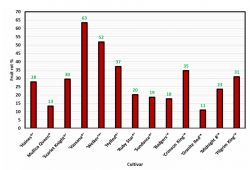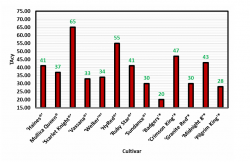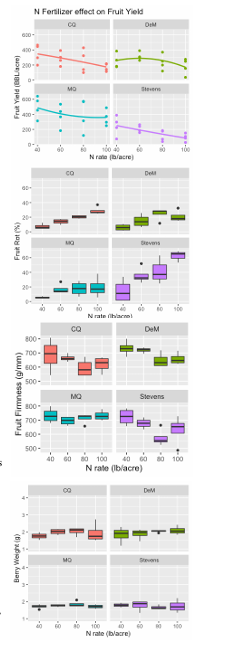News from the Entomology lab, Physiology/Fruit Quality lab, Physiology/Nuturion lab, Plant Pathology lab, Weed/IPM lab, Chart Book order form, and Station news
SELECTED HIGHLIGHTS OF THE 2023 CRANBERRY ENTOMOLOGY PROGRAM
OUTBREAKING INSECT PESTS: BIOLOGY AND MANAGEMENT
Black Bug – Plagiognathus repetitus
We monitored for a new insect pest, Cranberry black bug. Last year, crop loss was attributed to black bug injury by several growers. This past season, we confirmed vine deformation and crop loss at black bug aggregation sites. We surveyed and established that black bug appears to be established throughout MA acreage. It is tiny and difficult to distinguish from other common arthropods picked up in sweep net sampling. We found the highest populations at many no-input or low-input bogs in May. Injury occurred in spring from nymphal feeding; adults were present in July.
Blunt-nosed Leafhopper – Limottetix vaccinii
Distressing news from New Jersey colleagues reported very high levels of an old-time insect pest, Blunt-nosed leafhopper, together with extensive vine injury from False Blossom, a pathogen vectored by the leafhopper. There is no treatment for the False blossom disease, but the leafhoppers can be managed. However, detection and quantification of the tiny leafhopper is very difficult. Because the False blossom pathogen can be transferred in cut vines, we believe this is a dangerous issue that could impact bog renovation with new high- yield cultivars.
We surveyed extensively to determine the current status of Blunt nosed leafhopper and False blossom disease in MA. We found Blunt-nosed nymphs on no- or low-input bogs beginning in May and continuing through July. We made successful management recommendations. We set a long-term goal to disallow population buildup of Blunt nosed leafhopper in MA. We are advising high vigilance and a heavy-handed management approach.
Vaccinium scale insect – Diaspidiotus sp.
We have been dealing with this very serious species for over 10 years. We believe that through our sampling program, grower education, and management guidelines, the outbreak is receding. We established that this is a Vaccinium specialist, found only on cranberry and blueberry. Over the season, we visited 25 sites and microscopically inspected over 60 samples for scale infestation. We reported developmental status of the population to growers and provided management recommendations. Unlike 2022, the bulk of scale activity this season was in the spring, with few growers seeing damage in August or treating.
Management evaluation: A second year of evaluation was made at a site where vines had been treated with the environmentally-favorable insecticide ‘Senstar.’ Results were disappointing. There has been much discussion about future availability of Diazinon, the most effective management tool. We established that properly timed applications of the insecticide Fanfare were highly effective against scale.
OUTBREAKING INSECT PESTS: OUTREACH PROGRAMS
Workshops: The above outbreak pests are extremely difficult to identify and quantify, so we set up our lab with multiple microscope stations and conducted workshops where growers could bring in their sweep samples and develop a search image for the tiny outbreak pests. The sessions were preceded by a PPT information session. The three hands-on Workshops that we ran in May and June were well received!
New Written Materials
- Fact Sheet - Sylvia and Averill. Cranberry black bug in MA cranberry (Plagiognathus repetitus) (2 pp). March 2023
- Updated Fact Sheet - Sylvia and Averill. Vaccinium Scale in MA cranberry (4 pp). Feb 2023.
- Fact Sheet - Sylvia and Averill. Blunt-Nosed Leafhopper in MA Cranberry. Limottetix vaccinii (Van Duzee). (Hemiptera: Cicadellidae. (3 pp) May 2023
- Fact Sheet - Sylvia and Averill. Green spanworm in MA cranberry Macaria sulphurea (Lepidoptera: Geometridae). March 2023
- Fact Sheet - Sylvia and Averill. Collembola – ‘Springtails’ in MA Cranberry (2 pp) May 2023
MANAGEMENT OPTIONS FOR RESISTANT CRANBERRY WEEVIL
We identified a possible alternative for weevil management. We conducted a large field trial of a new and environmentally-favorable Syngenta compound, ISK-555. It is particularly aimed at the most refractory crop pests, for which existing insecticide classes are no longer effective. It is reported to have a long residue, a trait that would allow for longer spray intervals.
At one day after treatment (DAT) with medium and high-rate ISK-555, average counts of cranberry weevil treated were similar to counts of Actara (thiamethoxam) on treated plots. Actara is currently widely used but is problematic for its bee toxicity and our expectation of resistance development in weevil populations. There was not good evidence of high residual of ISK-555.
The work supports registrant forward movement of ISK-555 and provides an alternative to the very environmentally-unfriendly compound Fanfare (bifenthrin), which showed long residual control. There was no phytotoxicity of ISK-555. In a lab trial of green spanworm (Macaria sulphurea) held individually in cells, 100% mortality was observed on IK-555 treated foliage at a 2 oz rate.
News From the Physiology/Fruit Quality Lab
By Giverson Mupambi with support from Krystal DeMoranville, Brian Makeredza, and Manu Priya
SELECTED HIGHLIGHTS OF THE 2023 CRANBERRY PHYSIOLOGY/FRUIT QUALITY PROGRAM
Evaluation of new hybrid cultivars with improved disease resistance, fruit quality, and yield: We continued with our new cultivar screening trial aimed at increasing the profitability and sustainability of the Massachusetts (MA) cranberry industry. Thirteen new hybrid cultivars from New Jersey and Wisconsin breeding programs are being evaluated under rigorous scientific conditions.
Yield. Haines® was the best-performing cultivar. It produced 353 barrels per acre. It outperformed the five-year average yield of Mullica Queen®, which has the highest five-year average yield in MA. Welker™, Badgers, and Crimson King yielded over 200 barrels per acre. Only two cultivars yielded lower Early Black, which currently has the lowest five-year average yield in MA.
Fruit rot incidence. In general, we had very high fruit rot incidence, which is expected in a new planting. Vassana® and Welker™ had the highest incidence of fruit rot (over 50%). Mullica Queen®, Sundance, Badgers, and Granite Red had the lowest incidence of fruit rot (less than 20 %).
Fruit color (10/6/2023). As of the 6th of October, all the cultivars had TAcy values above 20, which is above the minimum required for harvest when using TAcy as a standard. The best color was observed in ScarletKnight® and HyRed®. The development of TAcy is expected to change when the canopies are fully developed, and more fruit become shaded within the canopy.
News From the Physiology/Nutrition Lab
By Peter Jeranyama with support from Sandeep Bhatti and Brian Makeredza
SELECTED HIGHLIGHTS OF THE 2023 CRANBERRY PHYSIOLOGY/NUTRITION AND FROST RESEARCH PROGRAM
Using Thermal Models for Spring Frost Management. Overwintering buds must acquire adequate winter hardening for protection against frost damage in the spring. Once buds have broken dormancy, the plant requires protection from cold temperatures and desiccating winds. We evaluated through trend analysis on frost occurrence when tolerance is at 25oF (Table 1). It seems as though frost occurrences are happening earlier in the season than was observed in the 1960s (Figure 1). Frost incidences seem to be occurring much earlier than known before and as such, frost prediction formulas for April 1-14 or for November 1-15 are not available. We are developing frost formulas to forecast for these periods and improving on the current formulas. The aim is to develop robust prediction models that do not miss a frost event and minimizes false positives and at the same time eliminating false negatives (this could have a catastrophic outcome).
| Tolerance oF | GDD oF | Growth Stage |
|---|---|---|
| 20 | 100 | White Bud Stage |
| 22 | 150 | Bud Swell Stage |
| 25 | 200 | Cabbage Head (Bud Break) |
Optimal Nitrogen Fertilizer Rates in Cranberry Hybrid Cultivars. Nitrogen is the most important element in cranberry production that impacts both vegetative growth and fruiting. Nitrogen fertilizer rates have been determined for native cultivars and for the first-generation hybrids such as “Stevens”, but field data to support N fertilizer recommendations for the second-generation “super” cultivars such as “Mullica Queen”, “Crimson Queen” and “Demoranville” are lacking. In this study, we will refine N fertilizer recommendations for hybrid cultivar (‘Stevens’), and all second generation cultivars planted in Massachusetts (‘Crimson Queen’, ‘Mullica Queen’, and ‘Demoranville’). Results for yield and fruit rot are presented in Figure 2.
Systems Approach to Managing the Expression of Cranberry Fruit Rot (SAME). I am a co-Principal Investigator on a Specialty Crops Research Initiative grant funded by USDA-NIFA-SCRI for four years on Systems Approach to Managing the Expression (SAME) of Cranberry Fruit Rot. I serve as the Project Leader for the research on fertilizer nitrogen effects on fruit rot incidence. This multidisciplinary project aims to understand and manage cranberry fruit rot. The objectives are as follows, (i) to develop molecular methods to identify pathogens and monitor pathogen sensitivity to fungicides regionally and at the farm level, (ii) to systematically evaluate the impact of fertilizer nitrogen and environmental stressors on fruit chemistry and symptom development, (iii) to identify genetic resources for cranberry fruit rot (CFR) resistance and stress tolerance that can be used to guide breeding, and (iv) develop predictive models for CFR management, examine the economics of CFR management, and distribute tailored solutions to growers throughout the US through extension networks and training. Results on berry firmness and weight are reported in Figure 2.
Cranberry Irrigation. Many growers tend to rely on the 1 inch per week “rule” from either rain, capillary action from the groundwater, irrigation or some combination of these from late spring through the summer despite evidence that in most years this results in some weeks with inadequate water and others with excess. In this project, I have tested wireless tensiometers, non-digital tensiometers, and moisture sensors and compared them to farmer practice for irrigation management. Water management is a critical issue affecting the cranberry industry due to impacts of management on crop yield and quality, environmental concerns with runoff, costs, and regulatory scrutiny. My research has shown a strong relationship between cranberry fruit yield or fruit rot with soil matric potential (tension), which suggests that cranberry yield and fruit rot is highly sensitive to either an excess or shortage of soil water.
News From the Plant Pathology Lab
By Leela Uppala with support from Krystal DeMoranville, Ethan Gioscia, Ambika Siddesh, Salisu Sulley and Shalini Yerukala
SELECTED HIGHLIGHTS OF THE 2023 CRANBERRY PLANT PATHOLOGY PROGRAM
Year to Year Characterization of Cranberry Fruit Rot (CFR) Fungi in Massachusetts: By employing multiplex PCR, we characterized CFR fungi from fruits sampled across southeastern MA fields for two growing seasons, 2021 and 2022. During both growing seasons, ripe rot caused by Coleophoma empetri was the most abundant pathogen detected across the locations with high relative abundance (35 and 39% in 2021 and 2022, respectively). This was followed by bitter rot (Colletotrichum spp. Glomerellaceae), berry speckle (Botryosphaeria vaccinii) and black rot (Allantophomopsis cytisporea; A. lycopodina and Stresseria geniculata) in 2021; and black rot (A. cytisporea; A. lycopodina and S. geniculate), blotch rot (Physalospora vaccinii) and bitter rot (Colletotrichum spp. Glomerellaceae) in 2022. CFR fungal species differed significantly among wild, organic, and conventional bogs.
Cranberry Microbiome Studies: We characterized the bacterial and fungal microbiome from wild, organic, and conventional cranberry bogs. We are continuing efforts to expand the shrinking CFR toolbox by evaluating novel fungicides from FRAC groups 2, 7, 3&7, 3&9, 3&11, 7&12, 9&12, coppers, and biologicals.
In collaboration with the Cape Cod Cranberry Growers’ Association (CCCGA), we are continuing studies in 23 southeastern Massachusetts bogs to elucidate various factors impacting fruit rot incidence and fruit quality, with an objective to develop best management guidelines. We are making progress towards identifying critical criteria that impact the outcome of late water floods in cranberry production with a goal of developing a decision-making model.
News From the Weed/IPM Lab
By Hilary Sandler and Katherine Ghantous with support from Krystal DeMoranville
SELECTED HIGHLIGHTS OF THE 2023 CRANBERRY WEED/IPM PROGRAM
Explore best use patterns for novel cranberry herbicides. The weed control spectrum of a recently labeled herbicide is mainly annual weeds, which are found more commonly on new plantings than established cranberry beds. A crop safety study was conducted on a new planting. Crop injury was noted for all rates tested. It was unclear if age of the planting, cranberry variety, application of sand prior to herbicide application, or excessive water from heavy precipitation events were factors in the crop response elicited. Previous trials in 2022 on established Stevens has excellent crop safety. More work with this compound is needed before grower recommendations can be made.
Zeus/Spartan safety on new plantings has not been well studied. A 2022 greenhouse experiment showed crop safety on rooted cuttings (plugs), but not on unrooted cuttings. A follow up field study in 2023 demonstrated good crop safety on three varieties on a new planting (established by plugs 2 years prior to treatment). Additional trials were done with the herbicide looking at postemergence application to poison ivy. Although significant weed control was not noted for this species, cranberry vines were able to tolerate applications without major injury. More work is needed to explore safety and efficacy of novel timings.
Alternative to glyphosate for woody weed management. Glyphosate remains registered, but ongoing litigation and negative public perception have spurred interest in finding possible alternatives. In 2022, we identified a promising herbicide used in non-food systems for woody weed management in a pilot study. In 2023 we studied potential use patterns by wiper application to maximize crop safety testing multiple application timings, including to dormant weeds on dormant beds. One timing was also executed by collaborators in WI and NJ. Results were promising, especially for dormant applications. Field work and discussions with the registrant will continue in 2024.
Exploring potential new tool for moss management. Although sulfentrazone has become the industry standard for managing moss in MA, additional tools are still needed due to the risk of crop injury and other factors. Sulfentrazone is effective for managing haircap moss and sphagnum spp., but other moss species are also emerging as weeds. We tested applications (single/multiple) of a copper compound or sulfentrazone against Aulacomnium palustre (ribbed bog moss). Multiple applications have the potential to provide season-long control, but a cost analysis must be completed to assess whether this is a practical management recommendation.










